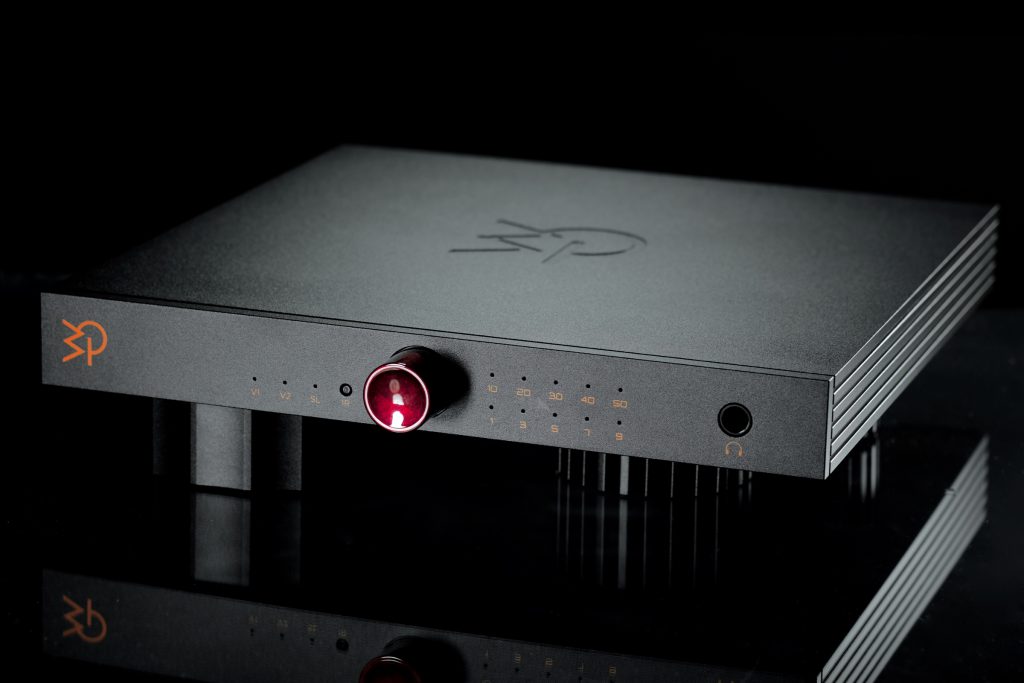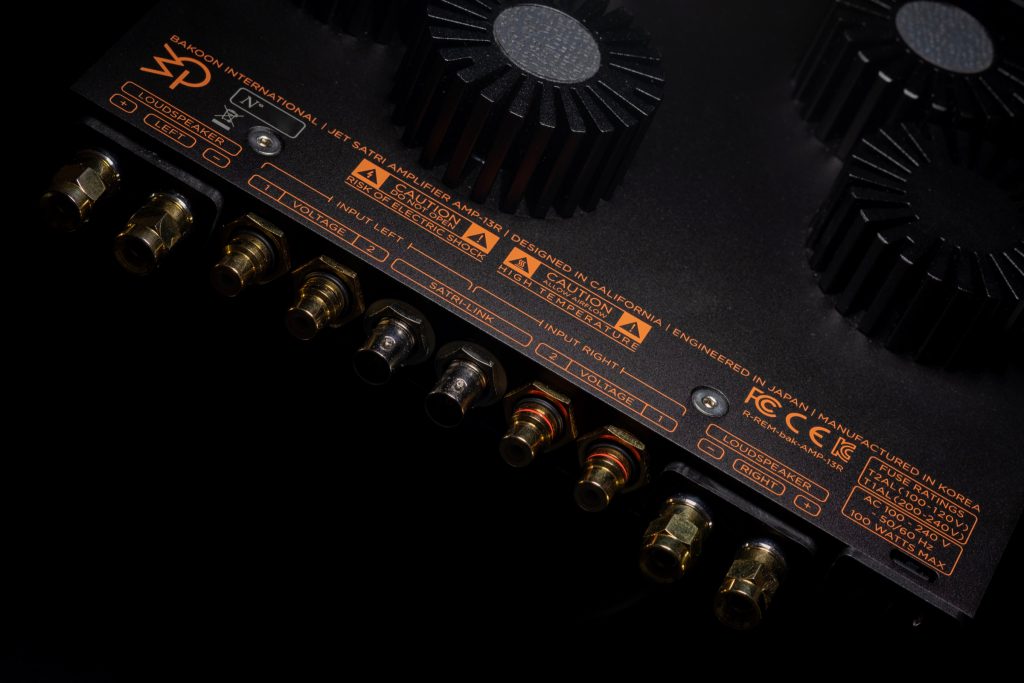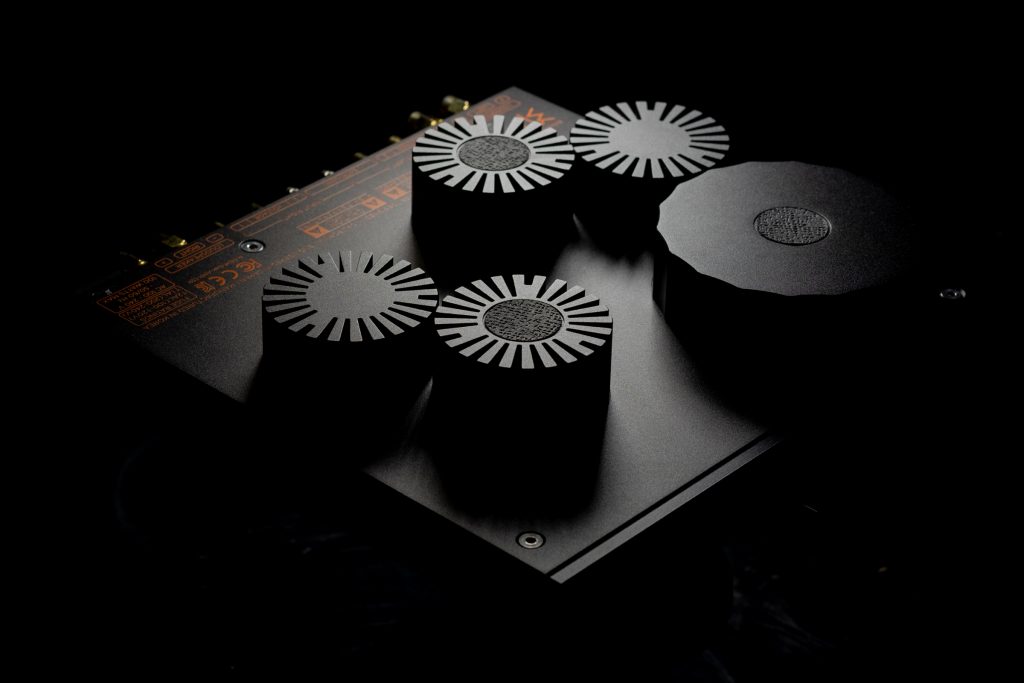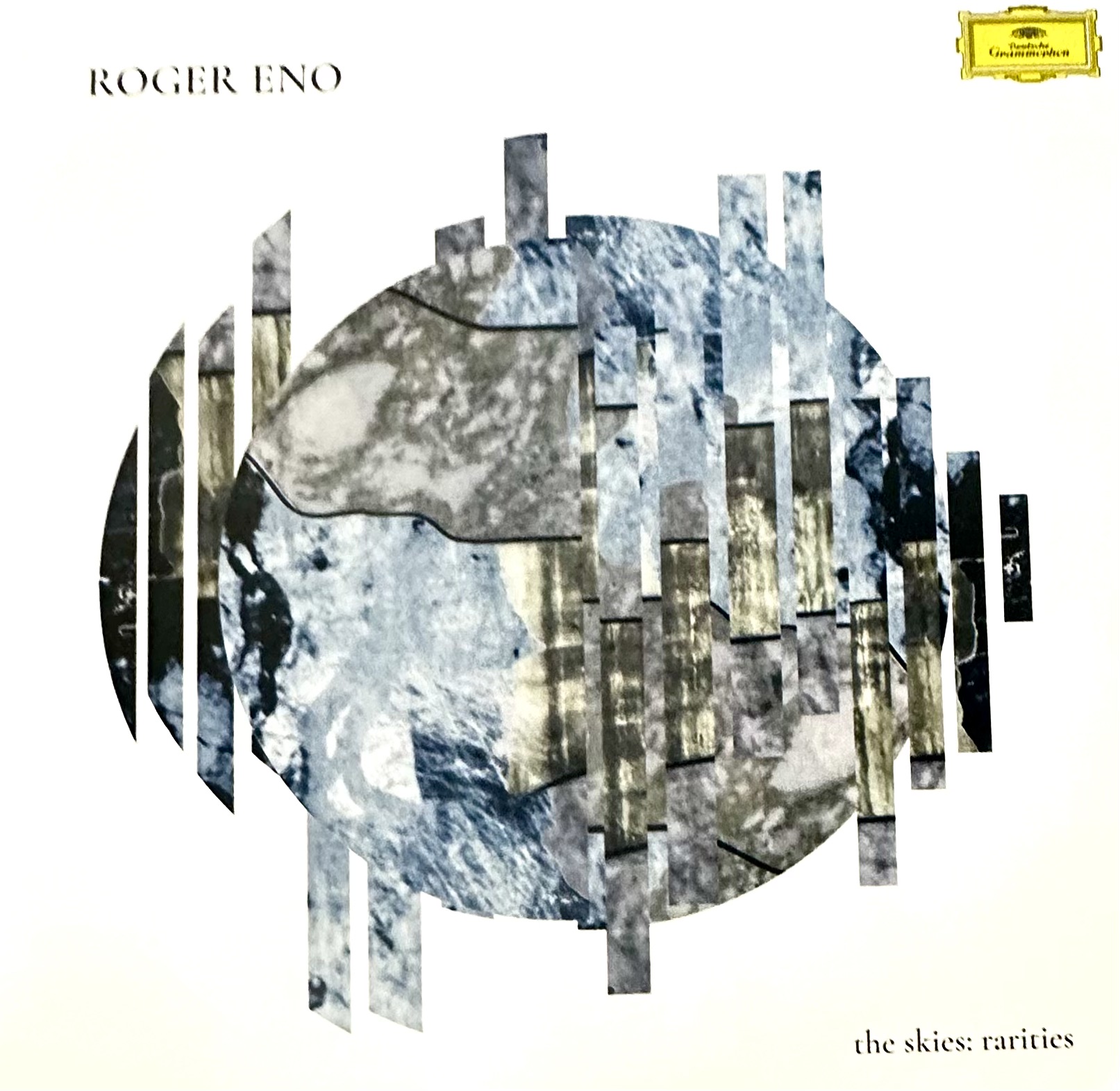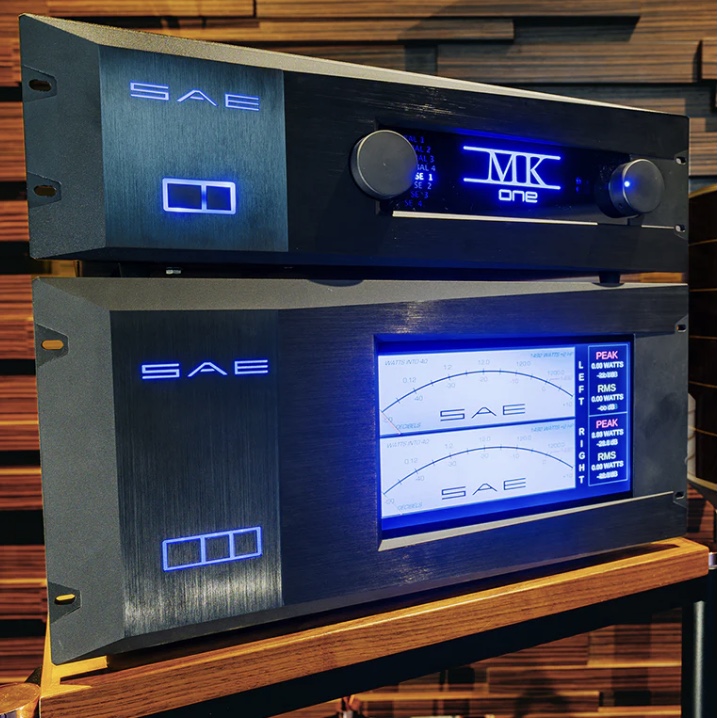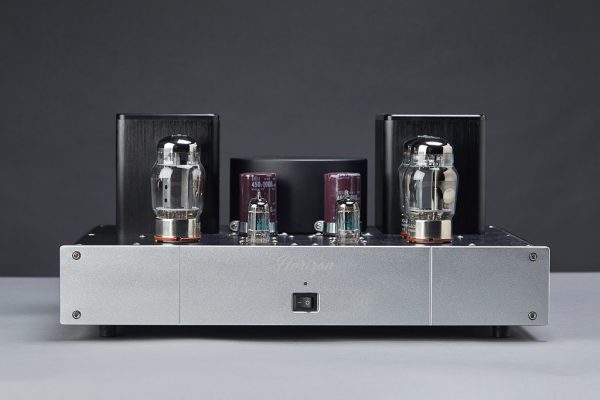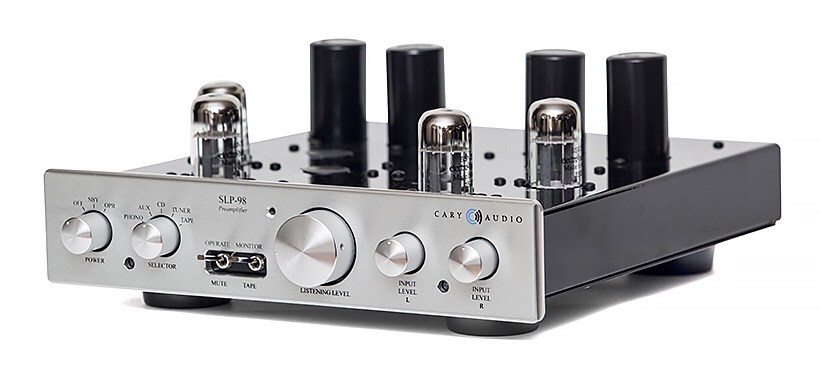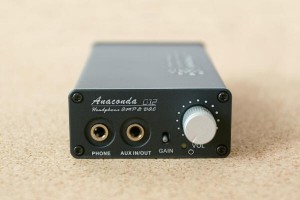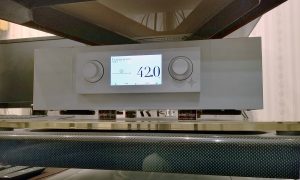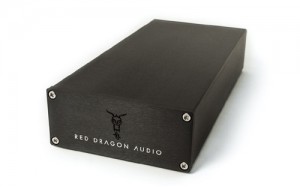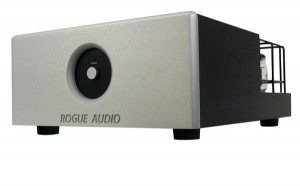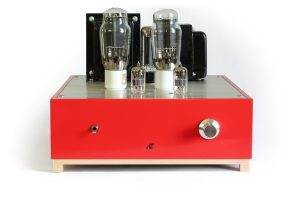They say a lot of things about small packages. "Good things come in small packages." There is a certain wisdom in that statement. Of course it rarely has an applicability to Heavy Weight Boxing! The professional athlete that goes 6'8" and plays, basketball, football, soccer, or whatever rarely feels that they would be better off being 5'4." There are plenty of situations where bigger is better but in HiFi, where there is a need and a proclivity of "bigger," the occasion where something special shows up and is dwarfed by the average sized component requires close examination.
Here in lies the Bakoon AMP-13R. David to the relative Goliath? Giant Killer? Sort of. Well read on and learn about this tiny Monster!
I am giving specs first and foremost, as telling this story with the specs in the middle just will not work. So here you go:
- Power Output : 25 watts (8 Ω, 1 kHz)
- Gain : 22.5 dB max. (speaker, headphone high) or 7 dB max. (headphone low)
- Gain Control : MPU Controlled 50 Stepped Attenuator
- Frequency Response : 10 Hz ~ 500 kHz
- Input : 1 SATRI-LINK (BNC), 2 Voltage (RCA)
- Input Impedance : 3.68 Ω (SATRI-LINK), 10 kΩ (Voltage)
- User Interface : Encoder with a built in switch, Remote Controller
- Power Consumption : 100 watts max.
- Dimensions : 230 mm (W) x 230 mm (D) x 55 mm (H)
- Weight : 4 kg (net), 5 kg (shipping)
What is actually quite interesting about Bakoon is some of their proprietary circuitry. So here is an explanation of what Bakoon feels makes the AMP-13R a notch above the competition.
JET SATRI Circuit
"With our breakthrough in bias circuit design, we've outdone ourselves." The patent-pending JET Bias circuit has brought the SATRI Circuit to a whole new level in terms of electrical performance and sound quality. Bakoon says it is an ultra fast, wide bandwidth, full discrete design with zero negative feedback. The circuit doesn't use output emitter resistors, resulting in lower output impedance than ever before, with direct, ultra-fast response to the loudspeakers.
JET Bias Circuit
JET is actually an abbreviation of "Jet," "Exact," and "Thermal Tracking." It's ultra-fast like a jet plane in terms of circuit response time and speed. The bias current is exactly fixed, and it doesn't drift at any condition. It's not affected by temperature variations as the temperature sensor tracks and adjusts the bias in milliseconds, or instantly. This patent-pending innovation is enabled by a separate ADC, DAC, and microprocessor (MPU) circuit stage with highly sophisticated, yet elegant software.
With the AMP-13R there is an elegant simplicity in design. The front panel measures merely 27.5mm or 1.08 inches in height, and most likely the slimmest analogue audio amplifier design ever created according to Bakoon. The design is also claimed to be very efficient in heat transfer to achieve almost double the output power compared to their previous generation amplifiers. The extreme calculations in mechanical engineering and tightest machining tolerance delivers one elegant design. As a Koetsu cartridge owner, the Urushi Vermillion in this case, I absolutely loved the detail touch of a red Urushi lacquered knob, "made by master craftsmen from Fukushima, Japan."
The new AMP-13R boasts three separate control microprocessors (MPU) to provide unparalleled efficiency in its design. By separating these MPUs, Bakoon have actually reduced the number of parts and signal complexities, yet still provide the same level of highly successful user interfaces of the bigger AMP-51R and AMP-41. Furthermore, given the small footprint and height, Bakoon had the highest demands on the actual transformer design. Bakoon turned to Avel Lindberg of Connecticut, USA to provide the transformers. The new power supply circuit is also of a very innovative design, as it provides the auto-sense voltage switching capability of the company's AMP-51R and AMP-41, but this time with only one power transformer, unlike past circuits, which required additional power transformer.
Upon unboxing the review sample, one of the first things I noticed, besides the diminutive size, was the interesting layout and labeling of the front panel. The control / volume knob was immediately impressive in its elegant Urushi finish, but the rest of the face plate was amazingly understated yet clearly well made and class, all part of the design parameter of simple elegance. The next thing you will notice is that transformer and heat sinks are on the bottom. They not only perform their normal electronic functions, but are also the feet of the unit. My review sample did not come with a user manual, but rather a schematic of controls nicely printed on the inside box. The remote is small, but robust and easy to use. The one thing that took me a bit to get used to was understanding the volume control levels. Rather than a simple linear ramp up there are multiple levels and steps within each level. It took a bit of playing with to get a command of the small lights on the front panel, and what they meant in reference to the volume I was actually selecting. Once you get used to these, they are quite straightforward and intuitive. The upper lows are 10s and the bottom lows are 1s (each LED represents odd numbers of 1, 3, 5, 7, 9 and even numbers are represented as two simultaneous LED lights – 1 and 3 will light up together to show 2) For example, to display gain step "32," three upper LEDs on top, and the first two LEDs on the bottom will light up. This allows to represent full 50 gain steps with only 10 LEDs.
The tiny foot print will automatically appeal to people looking to downsize their gear. This is an aspect of the audiophile journey I have been examining as of late. To put it in perspective, by my rudimentary calculations I could fit 12 of these amps into the cubic inches that comprise my Cary 805c amps. So in essence the Bakoon AMP-13R takes up 1/24th the space of my Cary amps. Mind you, the Bakoon is only a 25-watts per channel as opposed to the Cary's mighty 50-watts per channel. There again that is 25 solid-state watts versus 50 tube watts.
This is an elegant design. Paula said, "Why don't you just go with that little amp. It's so tiny and sounds pretty good." While I understand we are at that age of starting the downsizing for our last move, I am not quite there. However this little amp will certainly stay in my mind as I work through the inevitable.
The rear panel is certainly far more intuitive than the front panel. I say that with the understanding that the inputs / outputs are marked on the bottom of the amp rather on the back due to space restraints. Ultimately after the first five minutes, this presented no real issues at all.
The AMP-13R offers two sets of RCA inputs, one set of speaker outputs along with a set of SATRI links. The SATRI-Link, according to Soo In Chae of Bakoon, "is actually a current transmission method as opposed to conventional voltage transmission via RCA / BNC. It works together with our source components (DAC, Phono, etc) and amplifiers, and the idea is that the source's output impedance is very high and the amplifier's input impedance is very low. This is exactly opposite to the voltage method, and by doing this, the signals will not be affected by outside noise, and length, as the impedance is very high. It can work in 100 meters long as well." Since I did not have any other Bakoon products during the review I did not have an opportunity to test this, but I have no reason to not believe Soo In and his assessment. Perhaps in the future I will get another chance to review some of their products again and experience the SATRI-LINK for myself.
Obviously if you are planning to run two turntables (and a microphone- get it?), a reel to reel, music streamer, CD player, or any other add on above two items, you are out of luck. That being said, I could easily see this unit handling my 10" reel to reel and a streamer in a compact system using high quality monitors with reasonable sensitivity to accommodate the 25 watts. I will say right off that the AMP-13R drove my VSR4s to satisfying levels right out of the box. I let in run in for a bout 30 hours before sitting down for any serious listening.
So how did it sound as a stand alone integrated amp? Well the answer is pretty simple, impressive as hell. Once I had command of the controls it was quite easy to operate. Turn it on, select the input, and then go through the five levels for volume and dial it it, sit back and enjoy!
I did a good deal of listening through streaming my TIDAL account. I have set up a number of review playlists for this very purpose. My first list is all jazz instrumentals., one for female vocals, and one for mixed music with everything from heavy metal rock to orchestral classics. I also ran my turntable through the AMP-13R for a number of tracks along with some from my reel to reel to round things out.
First up was the instrumental jazz. If you are not a fan of Dr. John because you think of his music in terms of Creole laden Mardi Gras type music such as the tunes "Iko, Iko" or "I Was in the Right Place at the Wrong Time," then you are missing a great deal of the genius of Mac Rabbinek (Dr. John's real name).
"Tangerine" from the album Mercernary (Blue Note), is a jazzy tune infused with a bit of blues and features some pretty snazzy tinkling of the ivory's by the good Dr. The underlying rhythm section is driven by very sharp and solid drumming by Herman Earnest III. His snare is prominent along with the kick drum, and through my other amplifiers has a lot of snap and pop on the snare followed by impactful kick drum that is tight and right in step with David Barard's bass lines. All of which had great speed and solid control. Sharpness and the movement of air were strong. John Fohl's understated guitar was crystal clear and perfectly balanced. You get the level of pop in each single stroke of the pick without it overpowering anyone else in the line up. All this underpinned the great piano mastery of Dr. John, the piano had the requisite tunefulness that you would expect, and also a very good feeling of the percussive nature of the keys striking the strings. The soundstage was impressive in accuracy and location of each musician with a proper amount of air around each.
The next track was chosen for lower level dynamics and soundstaging. "Detour Ahead" by the Bill Evans Trio from the album Waltz for Debby (Concord/Fantasy) was part of sessions recorded live at the Village Vanguard, recorded before bassist Scott LaFaro's untimely and tragic death at the age 25 in an auto accident. This track certainly features Scott showcasing his amazing ability at such a young age. The track is sultry at its core, and the ambience of the club is clearly present. The trio is spaced with Scott to the left, Bill to the right, and drummer Paul Motian slightly behind both, in a corner behind Scott. Things that jumped out at me at first were the crispness with which the tinkling of glasses and background conversations came through. It reminded me that even the greatest musicians play to small audiences that don't focus on the wonderful gift of music they are being handed. (A pet peeve of mine is people talking over performances of any kind.) So the whole while you get a reminder that this is a very live performance in a rather small venue of the day. Scott's plucking of the bass strings is very palpable, and you can hear the flesh on the strings sound that is rather distinctive and very different than when a pick is used. It makes the bass playing more intimate in my opinion. When I get that true sense of being in the room it gives me goose bumps. Paul uses brushes on the drums for this track. If the reproduction of the brush sound is not spot on it drives me crazy, and I cannot listen for more than a minute or so. Fortunately, and thankfully, I was not tortured by this track. The brushes sounded organic and natural, not like nails on a chalk board. The cymbals were crisp and had good deal of proper decay. Bill's playing on the piano was both delicate and forceful where necessary, and he controls the volume through the amount of pressure applied to individual keys in a deft way that comes directly somewhere deep in the soul of a musician. All of this came with the intimacy of having the trio right in my listening room. Almost as if the wall went away, and suddenly I was transported to the venue. I wasn't the only one who noticed this effect. Impressive to be sure.
Next up I went 180 degrees to a track by the heavy metal band Ghost, The track "Faith" from the album Prequel (Lima Vista Universal) presents a pretty good thumping challenge for any amp. The Swedish band, known as much for their devotion to Satan, their unique sound provides a heavy metal sound track with vocals often that offer up a softening of the metal with a musicality that is intoxicating. Front man Tobias Forge and his band of Nameless Ghouls strike a very interesting balance. This track has a very dynamic intro, a solid drum intro followed by distorted and compressed guitars strumming the rhythm track with enough oomph that it kicks you straight in the gut. The power driven metal beat breaks right though to smash you in the face, and never lets up throughout the song. The note perfect delivery of the vocals by Tobias blend well with the rest of the music, and provide an interesting balance where nothing over powers anything else. The lead guitar solo of Nameless Ghoul 1 (or 2. I get them confused as they all look identical) tears through the balance to punch you straight in the face. The edge and sustain are perfect, and just enough in your face to put an exclamation point on the song. I chose this one to check the the commitment of the AMP-13R to go to the limit. It drove the decibels to an impressive level for a mere 25 watts, and had the house rocking. There was no amp induced distortion and zero breakup running at roughly 75% of max. The AMP-13R, along with Bakoon's other amplifiers, are actually power amplifiers with lossless gain control due to circuitry. The performance is linear from step 1 to 50 and the AMP-13R will reach its full gain of 22.5 dB at step 50, so your 75% of this will be about gain step 38, meaning it's still got more power left. It never faulted through this and a few other cuts from the album. The slam that metal requires was there in an ample amount. I could play rock through this amp all day and it wouldn't break a sweat. I know because I did it!
I moved on to listen to vinyl, especially a brand new unplaced Sara K album. From the album Play on Words (180 gram AudioNautes Recordings AN-1602) I chose the track, "If I Could Sing Your Blues!" This record was recorded directly from the master tapes, and the quality is breathtaking. On a system that delivers the music and pulls itself out of the way, there are interesting things about the song that provide a solid testing track. Opening the song is a trumpet, and on a high quality system it will seem as if the trumpet player is back and to the right in the deepest recesses of the corner of the room. Some variations of my system have knocked the wall completely down and placed the trumpet player outside. (My Cary 805Cs do this). While not to the degree the Cary's portray it, the AMP-13R put the player as deep in the corner as he could be without leaving the room. Sara's 4 string guitar is rendered with the right level of softness that only nylon strings can provide. Sara's voice has such exquisite control and range. Smokey and sultry is the best way I could describe it and a wonderful sense of phrasing that is just as unique as Joni Mitchell's. The AMP-13R delivers all of this with what I could best describe as a tonal neutrality.
I will caution people that this amp does have its limits, and those are restricted to what you can ask 25 watt amps to do with speakers that do not have a lofty sensitivity. I would have loved to review it with something like the Von Schweikert active VR44 or 55 that only require an amp to power mid and highs, or something along the lines of an Avant Garde Duo. I think it's a setup like this the AMP-13R would be fantastic and much more capable of delivering large scale music such as orchestral in a far more satisfying way than pedestrian high 80s to low 90s sensitivities.
Ultimate Headphone Amplifier
Bakoon has been on a long term quest to provide the absolute best headphone amp bar none.
"The best possible headphone playback has been our one ambitious requirement to fulfill since the beginning of our company. With the recent releases of our world class headphone amplifiers, we have gathered valuable experience and ideas to make even this a class above what can be expected from our AMP-13R amplifier. The JET SATRI Circuit allow a zero loss amplification factor change, which means one can fully enjoy the EXICON MOSFETs excellent sound quality, direct to the headphone. The AMP-13R also provides the highest output power we have ever designed and will drive any headphone available in the market with a breeze."
So is it the last word in headphone amps? I do not spend a great deal of my listening time using headphones, but I do find myself at times doing serious listening through the phones, and have reviewed some really fine headphone amps. My best experience with that genre was with a 300B headphone amp. I felt, at the time, and still do, that it would be hard to beat the intimacy of a set of 300Bs driving a set of headphones. The experience was all encompassing and entrancing. A lofty experience to try to best that with the AMP-13R. As I stated, I am not the guy to determine if the AMP-13R rises to the level of the greats, I can say that I found it to be as good as any headphone amp I have spent time with aside from cursory listens at shows. Great on detail, separation and focus when called for. Emphasis on that detail part. With my Grado SR325s I got so much more detail out of music than I have with any other headphone experience. The warmth was not on the level of the 300Bs, and vocals not quite as natural, but everything else? Holy cow I was blown away. If I were to need a dedicated headphone only amp I would look right at the AMP-13R. Perhaps a bit lofty for a headphone only amp, but well worth the price for the quality sound it produces!
So where does that leave the Bakoon AMP-13R? Well if you are looking for lots of power to handle a large listening room through a set of mid sensitivity speakers, and you need to plug in your turntable, streamer, CD player, and reel to reel... out in the cold, and this won't be the amp for you, unless you want a great headphone amp and it is in your budget. Where I see the AMP-13R working perfectly is for the audiophile who lives in confined spaces, and space is at a real premium. This amplifier takes up a mere 95 square inches, or roughly slightly smaller than a text book. Along with a pair of nice efficient monitors and a streamer, that person would have a very, very satisfying system. It could also be perfect for the audiophile who is just downsizing, and wants an amp that will drive to decent levels and provide a great headphone amp in a nice compact unit. Again, anyone wanting to bi-amp an active speaker or use a small amp certainly would not be the least bit disappointed.
The AMP-13R represents Bakoon's long journey of study in simplicity—in all aspects of making a great compact amplifier. In other words, quality over quantity. It is for those who require utmost performance in a simple setup, and they have strived to meet their highest expectations with the AMP-13R.
If any of that sounds like what you are looking for then check out the Bakoon AMP-13R it may well be the perfect amp for you and I doubt you would be sorry you bought it. As a matter of fact, I think you would be most happy!
Bakoon AMP-13R
Retail: $6000
Bakoon International Corp. (Korea)
Bakoon International Inc. (San Jose, CA)
+82.70.8677.5513




